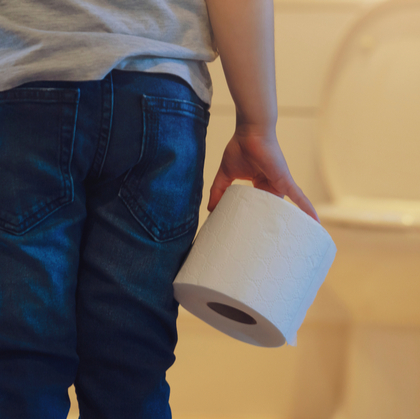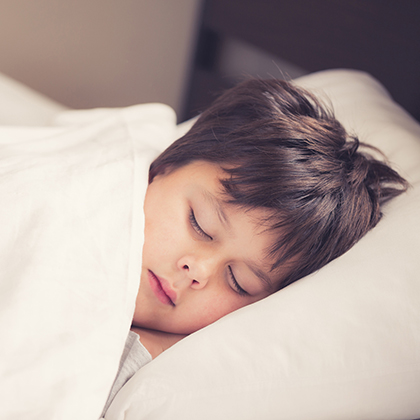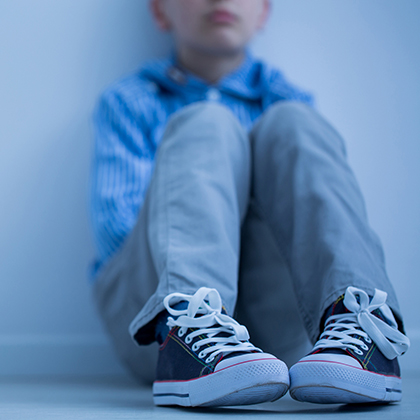
As its name suggests, cradle cap is a common condition in babies. Otherwise known as infantile seborrhoeic dermatitis (or infantile seborrhoeic eczema), cradle cap is a skin condition that most commonly affects a baby’s scalp – though it can also affect other areas of their body, mostly places where there’s a concentration of sebaceous (oil) glands (that is, areas of skin that tend to be greasier than others).
What is cradle cap caused by?
We don’t really know exactly what causes cradle cap – though we do know it isn’t a sign of poor hygiene. One theory is that it has something to do with developing sebaceous glands, and possibly that it’s a symptom of sebaceous glands that are overactive (iii). The National Eczema Society suggests a baby’s sebaceous glands may become overactive if they’re affected by the hormones from their mother that remain in their body shortly after they’re born – this could explain why cradle cap tends to clear up by the time a child reaches their first birthday (i).
Is cradle cap fungal?
Another theory is that cradle cap is caused by yeasts that live in the oily secretions (sebum) of human skin called Malassezia. Exactly what happens and how these yeasts are involved isn’t completely clear, though some believe the problem may be caused by the skin reacting to the yeast, resulting in inflammation (iv).
According to the National Eczema Society, babies with a family history of eczema and other skin conditions may be more likely to develop cradle cap. Some of these babies will also go on to develop atopic (allergy-related) eczema, particularly if they’ve had a bad case of cradle cap (i).
The good news is cradle cap isn’t serious or contagious, so you can’t catch it and pass it on to others by touching or stroking your baby’s head. And while the condition may not exactly look pleasant, it isn’t usually itchy and it shouldn’t bother your baby or cause them much – if any – discomfort.
How long does cradle cap last?
Most babies who experience cradle cap start developing symptoms before they reach three months old, with the condition usually clearing up by the time they reach six to12 months old (i). It’s difficult to estimate how many are affected, but according to the National Institute for Health and Care Excellence around 42 per cent of babies develop cradle cap (ii).
What does cradle cap look like?
Typical signs of cradle cap include greasy scales on a baby’s scalp. On babies with darker skin there may be pink patches or patches that are darker than the surrounding skin, along with white or grey scales. On white skin the scalp tends to become coated with large patches of waxy, yellowish or whitish scales that make the head look crusty.
The scales eventually turn flaky and fall off, often leaving behind red patches of skin. Sometimes the flaky scales fall off with some hair attached. This isn’t something to be concerned about because the hair grows back normally in time.
As well as the scalp, cradle cap can affect a baby’s eyebrows, forehead, temples, backs of their ears and the fold of their neck and the folds around their nose. In these areas the scales tend to be a bit less greasy and either pink/red or whiter or than those on the scalp – in fact in these areas the cradle cap may look more like a rash. The scales can be smaller too, though several scales may join up to form larger areas. Seborrhoeic dermatitis can also affect a baby’s nappy area, in which case it’s known as napkin dermatitis. This usually just affects the groin area, making the skin look red, inflamed and flaky.
Though it may sometimes look similar, napkin dermatitis isn’t the same as nappy rash – for more information on nappy rash, take a look at our nappy rash guide.
Other areas that can be affected include a baby’s armpits and the backs of their knees. Meanwhile it’s unlikely for the skin affected by cradle cap to become infected, as long as it doesn’t become broken (for this reason you should always try to avoid picking the crusts).
What else could it be?
It’s not always that easy to tell if your baby has cradle cap because there are several other skin problems that can look quite similar.
Cradle cap vs eczema
Both cradle cap and eczema can cause flaky or crusty skin, but whereas cradle cap isn’t that likely to irritate a baby’s skin eczema can be very itchy and uncomfortable. Cradle cap also usually clears up by the time a baby reaches their first birthday while eczema can last for much longer, even into adulthood in some cases.
Cradle cap vs dry skin
Dry skin on a baby’s head can also cause flakiness, but the flakes will tend to feel dry to the touch. With cradle cap, the flakes are usually more crusty in texture and will often feel greasy or oily rather than dry. Dry skin also usually produces white flakes, whereas typical cradle cap crusts look yellow or grey (or off-white as opposed to pure white).
Other conditions that can look like cradle cap include:
-
Impetigo (if the scales become infected)
-
Psoriasis (some experts even think seborrheic dermatitis in babies could actually be psoriasis) (v)
-
Nappy rash (if the nappy area is affected)
-
Fungal infections (such as ringworm)
-
Contact dermatitis (eczema caused by contact with an irritant or an allergen such as soap or detergent)
Cradle cap treatment
There isn’t usually any need to treat cradle cap as it tends to clear up by itself. But there are a few things you can do yourself at home that may be helpful:
-
Wash your baby’s scalp every few days using an unperfumed baby shampoo and lukewarm water (never use a shampoo or soap designed for adults as it could irritate your baby’s skin). While you’re shampooing don’t rub their skin, just massage it really gently to remove any crusts and flakes that are ready to fall off.
-
Use a very soft brush to loosen the scales before washing their scalp with baby shampoo. If you don’t have a soft hair brush, try using a new toothbrush with extra soft bristles.
-
If the scales don’t come off easily, soften them up first by massaging the affected area with baby oil, coconut oil, almond oil, petroleum jelly or an emollient moisturising lotion that you can buy at pharmacies. If the scales are very thick, try leaving the oil or moisturiser on overnight, then loosen them using a soft brush and shampoo the next morning.
One oil you should avoid using is peanut oil, as there’s a slight chance it could cause an allergic reaction. Years ago doctors used to recommend using olive oil to soften up cradle cap, but these days it’s a controversial issue – some experts say olive oil should be avoided because it causes even more problems while others still claim olive oil is safe to use. The NHS, however, states that olive oil should not be used as it may not be suitable for use on skin (vi).
-
If other areas of your baby’s body are affected, bathe them every day with an emollient soap substitute – don’t use soap on their skin.
When to see a GP for cradle cap
If the above self-help tips improve your baby’s scalp you shouldn’t have to do anything else. However see your GP if any of the following happen:
-
Your baby has crusty, scaly skin all over their body
-
They seem uncomfortable or distressed
-
They scratch the affected areas
-
The affected areas look red or swollen
-
The crusts bleed or leak fluid
-
Their skin isn’t improving after a few weeks of self-help treatment or it’s getting worse
Your GP can prescribe medical creams to treat your baby’s skin if needed, including antifungal and mild steroid creams.
What is the best home remedy for cradle cap?
If you’re breastfeeding, it’s a good idea to make sure your diet is as healthy as possible, since whatever you eat will be passed through to your baby too. There isn’t any evidence to suggest eating certain foods could increase your baby’s risk of developing cradle cap. However if you’re breastfeeding, just like everyone else, it’s a good idea to eat a balanced diet with at least five portions of fruit and vegetables a day, plenty of wholegrains, some lean protein, some healthy fats and as few processed sugary or fatty foods or drinks as possible.
You may also want to try eating oily fish regularly, as the omega-3 fatty acids found in fish such as salmon, fresh tuna, mackerel and sardines may help support skin health, as well as many other things. However if you’re breastfeeding – and also if you’re pregnant – the NHS recommends you limit yourself to two portions of oily fish a week (vii).
If you don’t like eating fish, or if you’re a vegetarian or a vegan, you can try taking a good-quality fish oil supplement or a supplement that sources omega-3 fatty acids from marine algae rather than fish.
Having a good diet is one thing, but being a new mum can often mean you don’t get the chance to eat as healthily as you should all of the time. If this is the case, you may want to consider taking a good-quality multivitamin and mineral supplement to make sure your body – and therefore your baby – is getting all the essential nutrients it needs. Always make sure that multivitamin and mineral supplement you take is safe and appropriate for breastfeeding mothers.
Find out more about the different types of multivitamins you can buy by reading our multivitamin and daily requirements guide.
Seborrhoeic dermatitis (cradle cap in adults)
Adults and teenagers can get cradle cap too, though it’s typically referred to as seborrheic dermatitis in anyone other than babies. According to the National Institute for Health and Care Excellence (NICE), around one to five percent of the general adult population is affected by seborrhoeic dermatitis (ii).
Just like in babies seborrhoeic dermatitis can affect oilier areas of your skin including your scalp and sometimes also your face (for example your eyebrows, around your nose, eyelids and behind your ears), upper chest and back, plus skin folds such as your underarm area, beneath your breasts and your groin. When it affects your scalp (and/or beard/moustache in men) it’s usually called dandruff.
If you have a mild case of seborrhoeic dermatitis you may not need any treatment. But if your symptoms are more troublesome you can use special soaps (or emollient soap substitutes) and anti-dandruff shampoos that you can buy over the counter at pharmacies. More severe cases may need treatment with prescription medications, including stronger antifungal shampoos or topical steroid creams to relieve skin inflammation.
Treatment for cradle cap in adults
If you’re experiencing seborrhoeic dermatitis as a teenager or adult, there may be something you can do to make life a bit easier.
First, try to identify things that could be triggering a flare-up – such as increased stress, using harsh soaps and detergents, cold temperatures, too much sun exposure or hormonal changes. If you find out what’s triggering your symptoms, there may be something you could do to avoid it, or at least manage it more effectively.
Keeping the affected areas of skin as clean and dry as possible may also be helpful. If your eyelids are affected, your doctor may recommend that you clean them regularly with cotton wool soaked in cooled, boiled water.
Find more information
Cradle cap may look unsightly, but it rarely troubles babies who develop it. Unless your baby’s symptoms get worse you shouldn’t have to see your GP about cradle cap as there are several things you can do yourself that can be helpful. The situation is also temporary, with most babies growing out of cradle cap by the time they reach their first birthday. Adults who develop seborrhoeic dermatitis, on the other hand, may find it’s a lifelong condition – but one that can be managed fairly easily if you take the appropriate steps. In the meantime, find out more about a wide range of health conditions by visiting our pharmacy health library.
References:
-
Available online: https://eczema.org/wp-content/uploads/Seborrhoeic-dermatitis-and-cradle-cap-in-infants-Sep-19-1.pdf
-
Available online: https://cks.nice.org.uk/topics/seborrhoeic-dermatitis/background-information/prevalence/
-
Available online: https://patient.info/skin-conditions/seborrhoeic-dermatitis-leaflet/seborrhoeic-dermatitis-in-babies-cradle-cap
-
Available online: https://www.pcds.org.uk/clinical-guidance/seborrhoeic-eczema
-
Available online: https://www.nhs.uk/conditions/cradle-cap/
-
Available online: https://www.nhs.uk/live-well/eat-well/food-types/fish-and-shellfish-nutrition/
Related Posts
Disclaimer: The information presented by Nature's Best is for informational purposes only. It is based on scientific studies (human, animal, or in vitro), clinical experience, or traditional usage as cited in each article. The results reported may not necessarily occur in all individuals. Self-treatment is not recommended for life-threatening conditions that require medical treatment under a doctor's care. For many of the conditions discussed, treatment with prescription or over the counter medication is also available. Consult your doctor, practitioner, and/or pharmacist for any health problem and before using any supplements or before making any changes in prescribed medications.

Christine
Christine Morgan has been a freelance health and wellbeing journalist for almost 20 years, having written for numerous publications including the Daily Mirror, S Magazine, Top Sante, Healthy, Woman & Home, Zest, Allergy, Healthy Times and Pregnancy & Birth; she has also edited several titles such as Women’ Health, Shine’s Real Health & Beauty and All About Health.
View More



